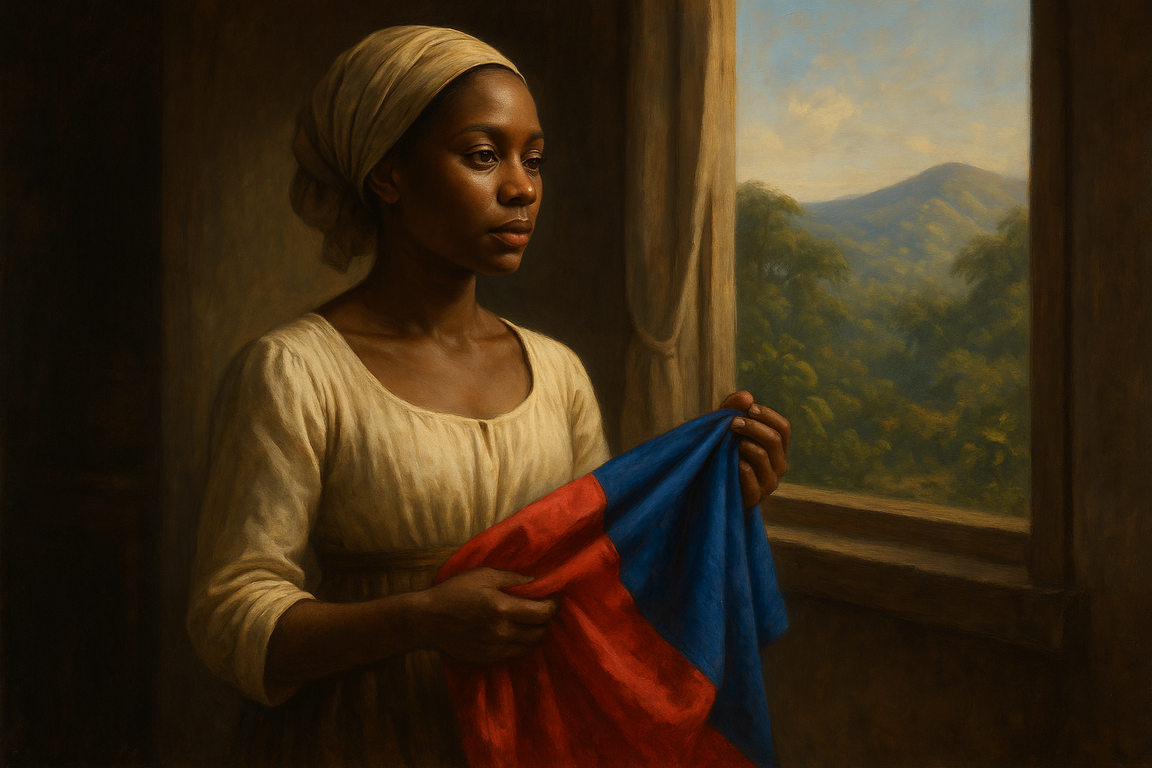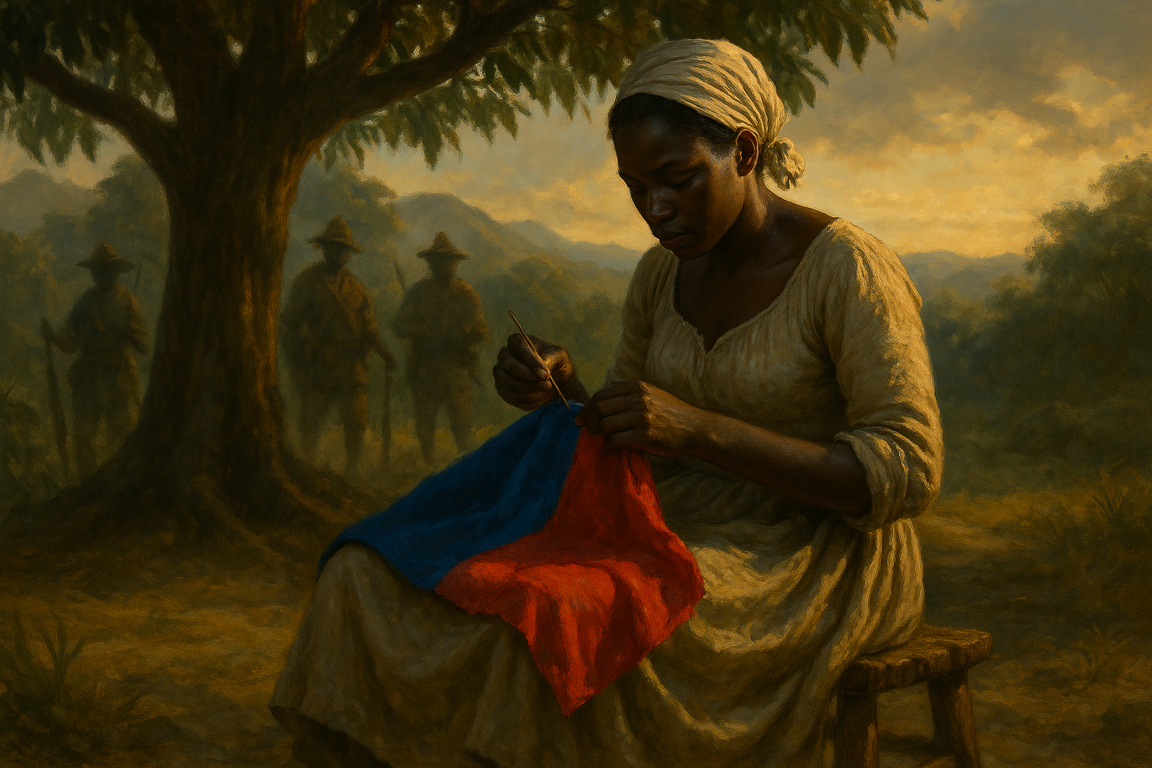Arcahaie, May 18, 1803. The air is heavy, tension runs high. In a feverish silence, a woman busily sews what her godfather, Jean-Jacques Dessalines, has just torn apart: the French tricolour flag. He has ripped out the white portion—symbol of the oppressor—and hands her the red and blue bands. She sews. And in sewing, she crafts more than a banner: she gives a face to the nation yet to be born. Her name is Catherine Flon.

A Woman in the shadows of giants
Among the great figures of the Haitian Revolution, history has primarily remembered male names: Toussaint Louverture, emblematic strategist of the initial insurrection; Jean-Jacques Dessalines, the general-turned-emperor and architect of independence; and Alexandre Pétion, a key figure of the post-revolutionary Creole Republic.
Alongside them, women were long relegated to the background, reduced to symbolic or anecdotal roles. A few names have emerged in popular memory: Cécile Fatiman, the priestess of Bois Caïman; Dédée Bazile, nicknamed Défilée the Madwoman, who retrieved Dessalines’s mutilated body. Yet one of the most well-known, though often confined to a domestic role, is Catherine Flon.
Born on December 2, 1772 in Arcahaie, a coastal town in the southwest region of Saint-Domingue, Flon grew up in a family engaged in textile trade with the French mainland. She learned the art of sewing early—a valued but strictly regulated skill in a colonial society where Black or mixed-race women were often limited to subordinate professions.
While detailed documentation is lacking—as is common for women of that era—sources agree that she owned her own workshop and trained apprentices, indicating a certain degree of economic and social autonomy.
More significantly: Catherine Flon was the goddaughter of Jean-Jacques Dessalines, a man born into slavery who became one of the most feared military leaders of the Haitian uprising. In the Afro-Creole world of Saint-Domingue, baptismal kinship—called marennaj—held almost familial significance. It bound individuals through pledges of protection, loyalty, and guidance.
This symbolic relationship placed Flon in a unique position. She was not merely close to power—she was embedded within a tight political circle, at the heart of the independence struggle. At a time when women’s access to public discourse was severely limited, her role in the events of 1803 signaled a form of implicit but critical engagement.
In this context, sewing cannot be dismissed as decorative or domestic. It becomes a tool of expression and subversion. With needle and thread, Flon contributes to a work of symbolic reconstruction: she mends what oppression had torn apart, shaping a nascent national identity.
Her figure illustrates the ability of women to weave their actions into the fabric of history—even when pushed to its invisible margins. In this, Catherine Flon is not an exception, but a symbol of a broader erasure that must be acknowledged and redressed.
1803: Sewing as a political act
On May 18, 1803, the military leaders of the indigenous army gathered in Arcahaie, north of Port-au-Prince, to solidify unity among the various factions of the Haitian uprising against Napoleon’s forces. This strategic meeting, known as the Congress of Arcahaie, marked a decisive step in the construction of a distinct political identity—separate from both the colonial model and the French republican paradigm.
During this congress, Jean-Jacques Dessalines, a central figure in Haiti’s independence, is said to have performed a potent symbolic act: the tearing of the French tricolour, from which he removed the white band—interpreted as the embodiment of colonial rule.
The remaining two bands, blue and red, were entrusted to Catherine Flon, his goddaughter, to sew together and form a new flag. This flag would become the emblem of the emerging political entity striving for liberation from France.
Flon’s intervention should not be reduced to a craft or decorative act. It was a political gesture: the thread and needle—tools of domestic order—become instruments of national re-foundation. This gesture marks a rupture—not only with the metropolis, but also through a reassembling of a collective project from the fragments of a dismantled order.
According to a later but widely accepted interpretation in Haitian consciousness, the blue represents the Blacks, and the red the Mulattoes. By sewing the two together, Flon symbolizes racial and social unity around a shared goal: sovereignty.
Though this reading emerged retrospectively, it helped incorporate Flon’s gesture into a Haitian republican mythology aimed at reinforcing national cohesion and acknowledging women’s contributions to state-building.
The importance of this act lies not solely in its factual accuracy—historians agree that blue-and-red flags were already circulating among revolutionary troops before the Arcahaie meeting. Some groups even used the banner to uphold the principles of the French Revolution—liberty, equality, fraternity—without necessarily seeking a complete break with France.
Still, the legend of Catherine Flon sewing the flag has acquired a performative power. It transforms a political event into a founding myth, giving a face, a gesture, a scene to Haiti’s symbolic birth. Within this framework, the presence of a woman—an artisan of national fabric—adds an inclusive dimension that transcends purely military narratives.
History or legend?
The role attributed to Catherine Flon in the creation of Haiti’s first flag belongs as much to revolutionary memory as to documented history. According to popular accounts, she sewed the blue and red flag at Dessalines’s request during the Arcahaie Congress in May 1803. However, this version is not supported by direct testimony or contemporary sources.
Historical evidence suggests that bicolour flags were already in circulation among the insurgents well before 1803, especially under Toussaint Louverture’s command. These banners, inspired by the French Revolution’s colours, were sometimes used not to declare independence, but to demand the implementation of the 1794 abolition law passed by the National Convention.
As such, several historians—including Philippe Girard—argue that the myth of Flon sewing the flag in Arcahaie may be a retrospective reconstruction, developed within a logic of national symbolism.
Nonetheless, the episode’s uncertain factuality does not lessen its symbolic resonance. The history of nations is often woven from founding narratives that distill values, tensions, and ideals into scenes memorable to the collective mind.
The gesture of Catherine Flon, whether historically accurate or not, serves as a structuring metaphor:
- It expresses racial and political unity between Blacks and Mulattoes during the war for independence.
- It introduces a female actor into a male-dominated revolutionary narrative.
- It embodies, through a simple act, the birth of a sovereign state free from colonial roots.
In other words, the Flon myth does not necessarily recount “what happened,” but rather what the Haitian nation sought to preserve and transmit: a founding gesture, a symbol of cohesion, and a symbolic space for female participation in the Republic’s creation.

Catherine Flon holds a unique place in the history of the Haitian Revolution. Though her direct involvement in creating the national flag remains historically uncertain, the symbolic weight of her gesture transcends factual debate.
She embodies a collective memory in which the act of sewing becomes one of foundation. By stitching the blue and red together, she gives form to both a break with the colonial order and a yearning for unity within a still-divided people.
More importantly, Catherine Flon introduces an active female figure into a revolution traditionally dominated by male exploits. She reminds us that national history is not built solely on battlefields, but also in the margins, in workshops, and through simple, enduring gestures.
In this sense, whether or not she literally sewed the first flag matters less than what her legend tells us about Haitian society: a desire for cohesion, a delayed recognition of women in the struggle, and a deep attachment to symbols imbued with meaning.
Even today, the memory of Catherine Flon continues to nourish Haiti’s political, cultural, and national identity, reminding us that in every revolution, it is often the heroes in the shadows who shape what becomes visible.
Sources
- Cécile Accilien, Jessica Adams, Elmide Méléance (eds.), Revolutionary Freedoms: A History of Survival, Strength and Imagination in Haiti, Caribbean Studies Press, 2006.
- Philippe R. Girard, “Birth of a Nation: The Creation of the Haitian Flag and Haiti’s French Revolutionary Heritage,” Journal of Haitian Studies, Vol. 15, No. 1/2, 2009, pp. 138–141.
- Holidays, Festivals, and Celebrations of the World Dictionary, Omnigraphics, 2015 (ed. H. Henderson).
- The Louverture Project, entry “Catherine Flon”: louvertureproject.org
- Remember Haiti Exhibit, John Carter Brown Library, section “Race and Slavery”.
- Warrior Women: Women and Armed Resistance Throughout the Diaspora (archived site).
Footnotes
- Haitian Revolution (1791–1804): Uprising of enslaved people against the French colonial system in Saint-Domingue. It led to the first successful abolition of slavery and the creation of an independent Black state.
- Cécile Fatiman: Vodou priestess and legendary figure of the Bois Caïman ceremony, said to have co-led the 1791 slave revolt with Boukman.
- Dédée Bazile (Défilée the Madwoman): A woman of the people said to have retrieved the mutilated body of Dessalines after his assassination in 1806 and given him a proper burial.
- Arcahaie: A town located northwest of Port-au-Prince, considered the symbolic birthplace of the Haitian flag. The Congress of Arcahaie is said to have taken place there in May 1803.
- Law of February 4, 1794: Decree by the French National Convention abolishing slavery in the colonies. It was partially implemented in Saint-Domingue before being revoked under Napoleon.
Table of Contents
- A Woman in the Shadows of Giants
- 1803: Sewing as a Political Act
- History or Legend?
- Sources
